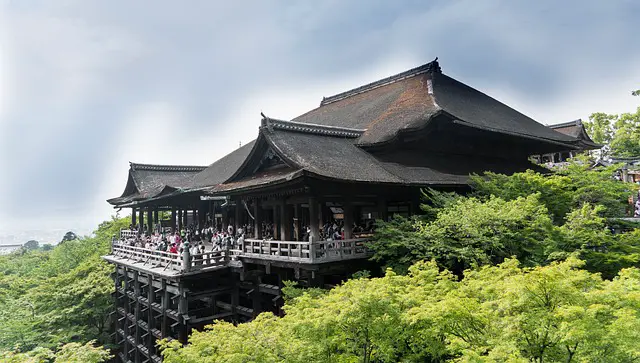This is how the situation is: you work in a position that absorbs your entire energy. You often fret, thinking that you can’t undertake your job well. It prevents you from meeting your friends and parents as much as you need to. Your house is situated in a hectic quarter of a city which you don’t even belong to. You have many items and you’re uncertain whether there is any necessity for all of them. In some way, you wound up in this situation.
The idea of wabi sabi from Japan possesses sagacity for the times in which life gives you this kind of sentiments. By means of plainness and making peace with our defects and with the fact that humans live only for a limited period, wabi sabi lets us perceive things anew. Wabi sabi shows us the way to make things easier and prioritize the right things. Doing these, it doesn’t put much pressure on people as they make the required alterations. Usually, it demonstrates people that the things they possess already are sufficient and there is magic around us every day. Everything that is necessary to do is to be informed about the way we can access it.

Chapter 1 – The most working way to make wabi sabi comprehensible is to contemplate the two lexeis individually.
It is possible to dwell in Japan from your birth to death and you may still not have heard the words wabi sabi in a speech. Kōjien, the most reliable lexicon of Japanese, presents no entry for these two words. You can find wabi and sabi separately, however, it’s not possible to learn what they mean when they’re brought together.
Rather, wabi sabi is present as an inexplicit philosophy, similar to an undetectable string going through Japanese life and culture. However, what is the thing wabi sabi signifies?
First, we’ll talk about wabi. In contemporary Japanese, wabi more or less means “subdued taste.” But at the beginning, the word was linked to poverty, insufficiency, and despondency, deriving from the verb wabiru, which means “to fret.”
In order to understand the whole meaning, however, it is necessary to travel back to the ancient tea ceremonies, which have had an important role in forming Japanese culture and life. At the times of the mid-sixteenth century, despite the existence of an emperor ruling Japan, the empire was actually under the sway of feudal lords called daimyo. The samurai warriors responsible for securing the daimyo’s forts and lands had started consuming tea in order to remain vigilant when they had been assigned to night watches. The ceremony that accompanied tea-drinking presented an opportunity to relish a time of peace in their lives that contain many brutalities hardships.
Shortly later, however, tea consumption began to be indispensable for the extravagant aristocratic life of the ruling classes, with embellished tearooms and kitchenwares. Instead of a serene ceremony exhibiting its Zen roots, tea began to be one other indulgence pastime.
Later, a tea master for the renowned daimyo Toyotomi Hideyoshi known as Sen no Rikyū determined to transform the tea ceremony. He gave up the extravagance of the tea ceremonies in the castles, preferring a more modest kind of ceremony, with modest tea wares and more petite tearooms. Instead of displaying wealth, it should have people enjoy the simplicity and original beauty. Rikyū’s form of tea ceremony began to be called wabi tea, or “wabi-cha.” Wabi, as you can understand, refers to a concept where simplicity, modesty, and thriftiness are valued.

We can see what sabi means now. If we tried to translate it into English, sabi would mean more or less “patina, antique look,” or “elegant simplicity.” Gradually, sabi has begun to mean a beauty that arises as time goes by – a recognition of weathering, tarnishing, and the signs of antiquity. In his well-known work, In Praise of Shadows, Jun’ichirō Tanizaki illustrates it greatly when he talks about the Japanese nation: “The Japanese do not dislike all the things that glitter, however, the Japanese do favor a reflective luster to a dull brightness…”
Brought into one term, wabi sabi refers to a perspective that values pure beauty, defect, and the impermanence of everything. It is especially stressed when this concept is contrasted with particular trends in the West – materialism, perfectionism, and the dread of facing the passage of time. In our rapid-paced consumption culture, it is possible to learn a lot of things from the concept of wabi sabi.
Chapter 2 – A wabi sabi home possesses deep emotions and simplicity.
You’re at home, sitting on a couch, and want to rest. However, something inside the room, this house, makes you feel uncomfortable. Your furniture is clean and tidy, a highly-priced wide-screen TV, and perfect speaker equipment, yet you don’t sense a connection to your house. You possess several items and decorations which you actually dislike. Your drawers and cupboards are full of unarranged stuff that irritates you a lot.
Should you feel the same as the paragraph written above, then it is possible for you to find comfort in the wisdom of wabi sabi.
For starters, in the wabi sabi home, defects are to be praised. It is unthinkable to dwell in rooms resembling something in Architect’s Digest or the most thoroughly prepared Instagram feeds. The most important thing to keep in mind is that homes are places to dwell. Home is the place in which people should find comfort. That indicates we should make peace with the often uneven, untidy contours that we incorporate into the places in which we dwell.
In order to remember this, we can take advantage of natural materials, such as wood and stone. These materials comprise naturally aesthetic imperfections – such as the knots in the wood, or the grooves in stone – that make us bear in mind that Earth is the same as us; it has beautiful defects.
In order to incorporate more of yourself into your residence, it is important to be wary of your sentiments during the decoration. To illustrate, it is possible to change a mere alcove through several items that kindle sentiments or recollections that you value greatly. Those items can be several stones or pieces of bark from your preferred beach or woodland walk.

Even if these special pieces of the world have the capacity to form an aloof space, a wabi sabi home puts great importance on removing unnecessary items as well. Instead of cold minimalism, the correct sort of removing unnecessary items can assist you to concentrate on what actually matters in your house. Those special items that kindle profound joy or thinking will glitter more in a room that provides them with space.
At this point, the lesson of Sen no Rikyū’s modest teahouse is successful. Now that there is more space since you decluttered your home, you can concentrate on the things that are actually significant, such as your bonds with others, your recollections, and the times of beauty in your life. The wabi sabi home, as you can notice, lets each of our defects appear; however, it also urges us to make our lives simpler in order to become closest to the things we appreciate most.
Chapter 3 – Wabi sabi involves harmonizing with nature.
After starting taking Japanese courses, you shortly later discover the profound extent the natural world is rooted in the language. The sounds we come across in nature have developed how the Japanese speak. A lot of words follow from nature. To give an example, the word kopokopo represents the soft bubbling of water and hyuhyu represents the sound of the whooshing wind.
In the same way as the Japanese language, the philosophy of wabi sabi promotes an intimate bond to the natural world.
If we attentively observe nature, we start to see an entire world of calm and uncomplicated magic. We start to be more integrated with nature as well. It is possible to see in haiku poetry penned by great masters like Matsuo Bashō and Kobayashi Issa. Generally, a haiku poem will extract a plain image from nature. Let’s look at the most prominent of Bashō’s haiku. The English translation is as follows:
The old pond
a frog jumps in
sound of water.
In this example, the sole thing to concentrate on is this natural marvel.

It is possible to notice this intense consciousness in the way the Japanese calculate their seasons. Instead of four seasons, the Japanese classical calendar comprises 24 smaller seasons called sekki, and 72 micro-seasons, called kō. These micro-seasons observe very attentively tiny differences in the world’s atmosphere and look. Those micro-seasons carry such names as Awakening of hibernated insects and Mist starts to hover.
In the present day, people usually overlook minute variations in the external world. Sadly, the same thing goes for our internal worlds as well. Contemporary life paralyzes us and we cannot receive signals from our minds and bodies, while we move between our job and the brightness of our TVs, phones, and computers. However, once people manage to discover how to notice minute variations in the natural world, they can begin to be more aware of their own rhythms. People will have the opportunity to understand if they need relaxation or activity, light or dark, trip, or home.
When our approach to nature is more attentive, one other feature of wabi sabi begins to be visible, too: the impermanent quality of everything. The beautiful cherry blossom withers, the mayfly passes away, and the snow thaws and runs down in the form of water from the mountains. This makes us think of our own transience and explains to us it is very important for us to concentrate on the things that are actually important early on instead of procrastinating.
Chapter 4 – Wabi sabi prompts us to adopt acceptance.
No one will oppose this statement: life occasionally presents impediments very difficult to surmount. However, unless we make with this grim reality, everything will become further challenging for us. If we cannot manage to be adaptable, not getting upset, and continue your life, it will be very difficult for you to navigate your way through life. Should life present us a hurdle, the most appropriate thing to carry out is to acquire the ability of acceptance.
For starters, it is necessary to be poised to accept the transformation. Since nothing is permanent, even stability, it is important to keep ourselves poised for adjustment to changing circumstances.
As happens usually most things, it is possible to make deductions from nature. Think about the climate where bamboo thrives. The climate usually comprises strong monsoons and hurricanes that come about out of nowhere. In the same fashion as a forest of bamboo in a storm, people need to understand how to be flexible instead of being rigid and how to proceed self-development, even if conditions transform.
Or think about the structures in numerous Japanese cities. These structures are planned to stand undamaged after earthquakes. After an earthquake occurs, the sole structures that continue to stand tall are the ones that bend with the shock. The fragile ones, on the other hands, break into the ground

This also applies to life. Occasionally, dramatic transformation disturbs the flow of our lives. Our bonds, professional lives, and well-being may undergo transformations in life-changing forms, and even if we hate it, that change is intangible. The promptly we make peace with this change, the better the outcome will be, since it is possible to adjust our behavior to the novel circumstances, no matter what it is – being made redundant or having an adulterous spouse or beloved. It is a lot more possible for us to endure the storm if it is possible to detect it while it is imminent.
Aside from transformation, another thing to understand how to do is to accept the person we are, and not endeavor for unattainable perfection. This perfection that people are urged to go after, is not the reality – The perfection pertains solely to advertisements or on excellently-prepared social media profiles.
Instead of getting angry at our own for not attaining perfection, we need to come to terms with the fact that life is disordered, imperfect, and never complete. Suppose you achieved the standards of living that resemble a life that is similar to a beachwear advertisement. Still, you will find it different from your ideal: life is essentially not flawless. And once we’ve come to terms with that fundamental reality, we should understand that most of the things we possess now – in its own way – excellently imperfect.
Chapter 5 – Wabi sabi shows us the way to tackle learning and failure in a wholesomer fashion.
A poor mark earned in an exam. A rejection message from a publishing house. A driving test you couldn’t pass. All of us have experienced these. Learning and failing are potentially upsetting. But, we can reverse this should we understand how to tackle both, using the outlook of wabi sabi.
There is no end for learning – you’ll never learn anything fully.
To illustrate, look at the writer’s story. She strived a lot to learn Japanese at Durham University in Great Britain. Through the diverse periods of her course, she was sometimes very confident and sometimes hurt. From not even being able to keep up with her studies that she was almost banned from the year abroad to then professional career as an accomplished interpreter in Japan, she has had many experiences during her education when she felt either incompetent or perfect.
The fact is that learning is a road without an end, and it is important to tackle learning keeping this in mind. After people begin to learn something – another language, a musical instrument, or accounting and so on – it is a good knowledge to possess beforehand that there is no end to the road they are going. Learning will present impediments and unexpected progress, however, there won’t be any finalization.

After grasping this, people should also understand there are those who advance perfectly in learning and those who lag behind. You should never contrast yourself with them – you should concentrate solely on your own road.
Learning has no finalization and failure plays a fundamental role in that. Instead of a terrible result, failure may yield a possibility for further development. To illustrate, consider the story of a long-distance swimmer, Ken Igarashi. An avid swimmer ever since his days in high school, Igarashi then entered into a professional career and established a family, prior to his restart to swimming in his mid-thirties. One day, he tried to swim across the English Channel in 15 hours. Beginning his attempt in the first hours and suffering from the consequences of the sleeping pills and whiskey he’d drunk as a remedy for jet lag, he started to stop short of his goal of 15 hours. Unfortunately, he couldn’t attain his goal; however, he swam across the English Channel over 16 hours later.
But, instead of being disheartened by missing his goal, he was happy to have been able to swim to the French coast – since it was his earliest international crossing and an extraordinary accomplishment nevertheless. Igarashi reviewed his “failure” and made some important deductions with regard to his own strength levels. Soon after this, Igarashi made headlines as the first Japanese to swim from Japan to Korea, and the first person to swim across Lake Baikal in Russia.
It is significant to review our failures as did Ken Igarashi. Failure is not the end of everything; it is a valuable lesson. Whenever we experience failure, we obtain the chance to notice things regarding ourselves, which could have remained invisible otherwise.
Chapter 6 – The complete wabi sabi of the tea ceremony has the potential of providing assistance in our personal relationships.
In Japan, a tea ceremony is an event where it is important to be careful of and helpful to each other. In this event, people give consideration and attention.
It hinges on four principles: wa kei sei jaku, which in English sort of mean “harmony,” “reverence,” “purity,” and “serenity.” However, there is no necessity for them to start and cease with the tea ceremony: It is possible to bring them into our lives.
Let’s think about the separate meanings of these principles, in terms of our relationships.
Let’s start with wa, which is equal to harmony. Which ways could you apply more in your relationships to foster harmony? Suppose the other person has a distinct sort of energy – maybe he’s got an anxious character. In order to render your connection with him more congruous, you could make efforts to render him comfortable during your meetings or when you relay the news to him. Perhaps, you could do achieve this by means of a simple gesture or by using a more tranquil tone while talking.
The next concept to examine is kei, which means reverence. Which quality do you revere in a person that you can share with him or her? Perhaps, this quality isn’t something that one would first think of while making a guess or is uncelebrated. Maybe you’ve got a buddy who, in any event, will never hold back the honest truth from you, even if the truth itself is harsh. So, there is no harm in sharing this with them.
The next one is sei, which means purity. For the tea ceremony, sei is about how guests who enter the tearoom would wash their hands to demonstrate reverence and consideration to the other tea-drinkers. However, it encompasses the purity of the heart, too, as a notice to look for the best in one another.

If you try to seek out for the best in people, what are the things you notice? Were you to have a dispute with them and still to be able to see the best in them, what could differ today? Think about this instance the author gives. It caught her attention that her spouse constantly put a wet drying-towel on the kitchen top. She had been quite mad about it until she understood that he’d put it after he’d prepared dinner, finished all the washing up, sent their kids to sleep, hugged her, and asked her how her day was!
Finally, there is jaku, which means serenity. In order for you to genuinely bond with others, you should have space and tranquility. Sometimes, there should be just you and the other person – maybe you can do a long walk, or have a calm coffee in a cafe corner. No matter which one you favor, what’s the way of creating more space and serenity in your time together?
Chapter 7 – Wabi sabi-motivated sagacity can assist you in your professional life.
You’ve recently gotten wind of some office gossip: your archenemy is going to be given a higher position. Upon hearing this, you feel as if being hit by a truck. You don’t feel unwell just because he’s gotten promotion – the reason is that you merit a new position as well. You start to pose some probing questions to yourself. What makes them get promoted and not me? What is the reason for me being not as accomplished as others?
All of us have gone through the same process. In the end, however, this sort of professional life pressure is going to yield any positive outcomes neither for you nor for others.
As you’ve read previously, wabi sabi urges us to be mindful of the concept of perfection. This also applies to our professional lives, too, the indication of which is that it is not a good thing to contrast our place in life with that of other people – all professional lives are extremely private to people, and each has their setbacks and upsides. Your coworker who has recently gotten a promotion that you are jealous of has most likely faced difficult times before. The writer who has recently been given a huge literary prize will most likely have gotten rejection letters in the past.
Such a thing as an excellently-managed professional life doesn’t exist. Most people follow tracks full of challenges to come to where we desire to reach– and, maybe, it’s solely via such a difficult track that we can attain the position or objective that we crave for.
Actually, wabi sabi, which holds high esteem of the passage of time, shows us that the path matter much more than where we want to be. In Japanese, there is a character that is pronounced dō, meaning “the way” if it is brought together with other characters. It is familiar to us from such words as judō, meaning “the way of gentleness”, sadō, “the way of tea”, and karatedō – called “karate” as well – which means “the way of the empty hand.” The knowledge we acquire from each of these distinct practices is that the way towards something – which includes the most crucial lessons – matters much more than where you arrive.

This also applies to our professional life. Usually, in the West, we want to achieve perfection and completion swiftly. We strain ourselves to get to the endpoint – this endpoint can be an elusive promotion or book deal. However, this involves occasionally going through terrible disappointment unless you manage to make things fit to your timescale.
Rather, it is important to look at the long road of our professional lives with the patience of the judoka, the jūdō master, who comprehends that one cannot reach an endpoint and that what we learn on our path toward an endpoint are what matters most.
Chapter 8 – Wabi sabi can assist us to accept aging and value the time we have in the world.
A line of tombs in a close graveyard. A list of memorial services in the regional press. A popular celebrity’s passing in the media. All of us are circled with reminders of our own death.
The fact is that people worry about aging – we strive and fend it off no matter what. Seldom one can look at the TV without passing a commercial for an antiaging cream or treatment.
However, while people try to develop elixirs for eternity, they ignore the advantages that accompany aging, such as wisdom and judgment, which are the products of experience. A life that is lived in line with the wabi sabi philosophy values these things in the same way it values the passing beauty of antique objects.
Wabi sabi guides us to welcome aging and to unwind while entering the final part of our time on Earth. While we’re easing down into aging, it’s important to see another crucial part of wabi sabi: everything is transient. However, no need to worry. If people accept that we live for a short period in the world, it assists us in discovering value and sense in it. This allows us to value moments with the people that are dearest to us, or do the stuff we like doing most.
Moreover, even though you’re still young, it has the capacity of assisting you to concentrate your mind if you candidly accept this transience. For example, which things would you change were you to be informed that you would just live 10 years? Or just one year? Looking at things from this perspective can assist you to understand what you prioritize.

But, instead of putting pressure on yourself to find the “perfect” life, you’ll feel happier if you acknowledge the sole genuine perfection can be seen in the magic of the everyday. A genuine embrace from a buddy. The blackbird looking at you while you work from the garden. The fragrance of newly-brewed coffee.
Occasionally, writing these things down has the potential of assistance to you as well, which reminds you to value them. The eleventh-century poetess Sei Shōnagon wrote down her preferred things, in such lists as “Things to Quicken the Heart” or “Things That Rekindle an Affectionate Reminiscence of the Past,” in order not to forget what she enjoyed.
Just as Sei Shōnagon did, people also should seek the modest, deep beauty in the world surrounding them, while there is still have time.
Wabi Sabi: Japanese Wisdom for a Perfectly Imperfect Life by Beth Kempton Book Review
Wabi sabi is an idea that is present invisibly in Japan and it is not usually talked about. This idea appreciates simplicity and imperfection while acknowledging the transience of everything. It is possible to make a lot of deductions from its philosophy, about our relationships with others, our professional roads, our tackling of failure, and how we adorn our houses. Instead of putting needless stress on ourselves in the search of perfection, wabi sabi urges us to appreciate the perfectly imperfect.
Discover how to take notice of the birds.
If you decide to wander around outside, try to implement it and look for birds or bird sounds. What are their appearances? How is their sound? Which species of birds do you like? Then, after going back to your house, utilizing a guidebook or the internet, try to understand whether you’ll be able to distinguish every bird you noticed on your stroll and write the ones you distinguished down.
